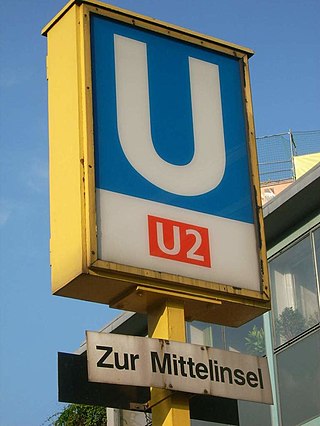
U2 is a line of the Berlin U-Bahn. The U2 line starts at Pankow S-Bahn station, runs through the eastern city centre (Alexanderplatz) to Potsdamer Platz, the western city centre and finally to the Ruhleben terminal station.
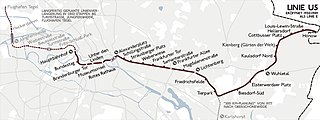
U5 is a line on the Berlin U-Bahn. It runs from Hauptbahnhof in Mitte eastwards through Alexanderplatz, Friedrichshain, Lichtenberg and Friedrichsfelde, surfaces in Biesdorf-Süd to pass Kaulsdorf and Hellersdorf above ground and finally reaches city limits at Hönow.

U6 is a Berlin U-Bahn line, 19.9 km (12.4 mi) long line with 29 stations. It runs in a north-south direction from the Berlin locality of Tegel in the north via Friedrichstraße to Mariendorf, a locality in the southern part of the city. It is a so-called large profile ("Großprofil") line.
U8 is a line on the Berlin U-Bahn. It has 24 stations and is 18.1 km (11.2 mi) long. The U8 is one of three north–south Berlin U-Bahn lines, and runs from Wittenau to Neukölln via Gesundbrunnen. The original proposal was for a suspended monorail like the Wuppertal Schwebebahn.
U9 is a line on the Berlin U-Bahn. The line was opened on 28 August 1961 as Line G.
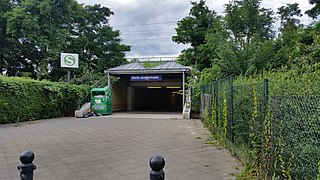
Berlin Jungfernheide is a railway station located at Charlottenburg-Nord, in the Charlottenburg-Wilmersdorf district of Berlin, served by the S-Bahn lines and , the U-Bahn line and Regional-Express trains of the Deutsche Bahn. Its name literally translates into "maidens' heathland"; it was named after the Jungfernheide, a former large forest in the proximity of this station.
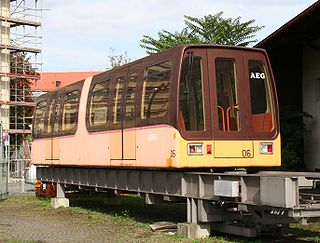
The M-Bahn or Magnetbahn was an elevated Maglev train line operating in Berlin, Germany, experimentally from 1984 and in passenger operation from 1989 to 1991. The line was 1.6 kilometres (1 mi) in length, and featured three stations, two of which were newly constructed. Presumed to be the future of rail transit in Berlin, the line was built to fill a gap in the West Berlin public transport network created by the construction of the Berlin Wall. It was rendered redundant by the reunification of Berlin and was closed to enable reconstruction of the U2 line.

Vinetastraße is a Berlin U-Bahn station in the Pankow district, located on the . It was opened in 1930, and for decades was the northern terminus of the U2, until the line was extended to the Pankow S-Bahn station in 2000.

Weberwiese is a Berlin U-Bahn station located on the line, which currently runs from Berlin Central Station to Hönow. The station is located under Karl-Marx-Allee directly east of Straße der Pariser Kommune. Although the next station on the line is called Frankfurter Tor, the historical city gate Frankfurter Tor actually stood at the location of the Weberwiese station. Several of the stations on this line have been recently redeveloped and are now colour-coded. In 2003, Weberwiese station was renovated and now has a very different appearance, with yellow tiles in contrast to its former white ones.

Friedrichsfelde is a Berlin U-Bahn station located on the in the Friedrichsfelde district.

Biesdorf-Süd is a surface level Berlin U-Bahn station located on the line of the U-Bahn Berlin subway in the neighborhood of Biesdorf in Berlin, Germany. The station opened on 1 July, 1988. After Tierpark, It comes above ground. The next station is Elsterwerdaer Platz. North of the U-Bahn station is the Biesdorfer Baggersee.

Wuhletal is a railway station in the Marzahn-Hellersdorf district of Berlin. It is served by the S-Bahn line and the U-Bahn line .

Louis-Lewin-Straße is a surface level Berlin U-Bahn station in the German capital city of Berlin. It is part of the Berlin U-Bahn; the station is located on the line.

Berlin-Wittenau (in German S-Bahnhof Berlin-Wittenau, officially Wittenau (Wilhelmsruher Damm)) is a railway station in the Wittenau district of Berlin, Germany. It is served by the Berlin S-Bahn and numerous local buses. It is also the northern terminus of the Berlin U-Bahn line .

Berlin Hermannstraße is a railway station in the Neukölln district of Berlin. It is served by the S-Bahn lines , , , and and the U-Bahn line , of which it is the southern terminus. It was formerly also possible to transfer there to the Neukölln-Mittenwalde railway line, which is now only used for goods traffic.

The North–South S-Bahn Tunnel is the central section of the North–South transversal Berlin S-Bahn connection crossing the city centre. It is not to be confused with the Tunnel Nord-Süd-Fernbahn, the central tunnel part of the North–South main line used by intercity and regional trains. The S-Bahn North–South line encompasses the route from Bornholmer Straße and Gesundbrunnen via Friedrichstraße and Anhalter Bahnhof to Papestraße and Schöneberg.
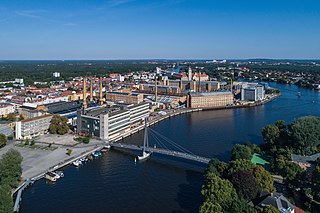
Oberschöneweide is a German locality (Ortsteil) within the Berlin borough (Bezirk) of Treptow-Köpenick. It is, with Niederschöneweide, part of the geographic area of Schöneweide. Until 2001 it was part of the former borough of Köpenick.

The Berlin U-Bahn originated in 1880 with Werner Siemens' idea to build an urban railway in Berlin. During the nine years after the German Empire was founded, the city's population grew by over one-third and traffic problems increased. In 1896, Siemens & Halske began to construct the first stretch of overhead railway. On 1 April 1897, the company began construction of an electric underground railway. The Berliner Verkehrs Aktiengesellschaft (BVG) was formed in 1928, and took over further construction and operation of the network. In 1938, the company was renamed Berlin Transport Company; the original acronym, however, remained. Since 1994, the BVG has been a public company.

Class E was a series of Großprofil multiple units of Berliner Verkehrsbetriebe (BVG) which was exclusively used on East Berlin line E, today line U5 of the Berlin U-Bahn. Except for the two prototypes, all vehicles were built using parts of retired S-Bahn vehicles, namely the bogies and parts of the electrical equipment.
The tracks of the Berlin subway are lines operated in the line traffic, operating distances, which serve only internal purposes, turn-off and turning plants and plants in the operating farms.
![]() . It is named after the Tierpark Berlin, one of the two zoological gardens in Berlin.
. It is named after the Tierpark Berlin, one of the two zoological gardens in Berlin.
















